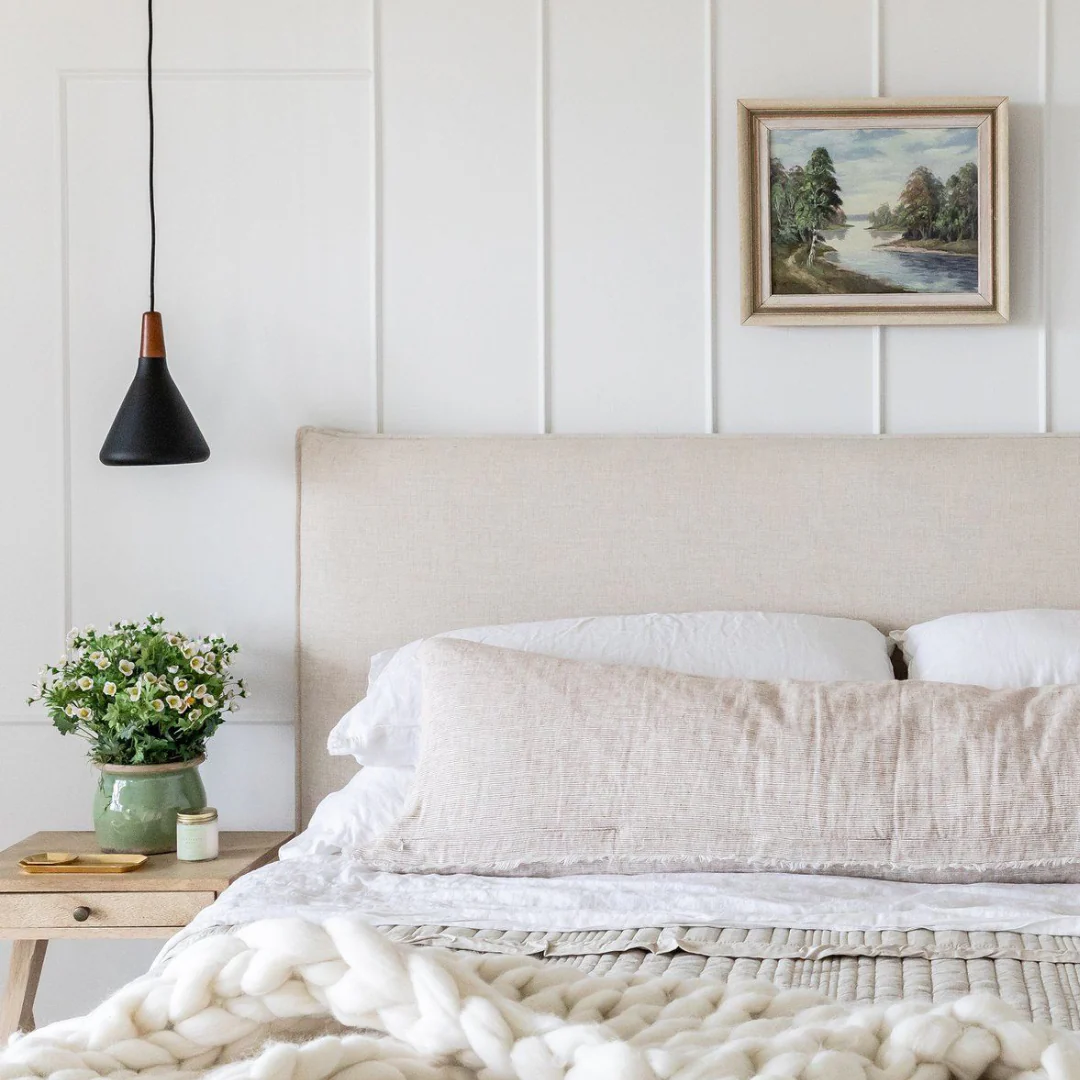The perfect room for a restful night
Discover our methods for creating the ideal sleep environment and improving the efficiency of your bedroom for a better night's rest.
In this article, we'll summarize the essential elements for creating an ideal sleep-friendly bedroom.
Explore the secrets to crafting a sleep sanctuary that you'll love, from choosing the perfect mattress to enhancing lighting and decor.

The Ideal Mattress:
When creating an ideal sleep environment, choosing the right mattress is crucial for a restful night's sleep.
There are different types of mattresses available, each with unique features and benefits.
For instance, memory foam mattresses conform to your body's shape, providing excellent pressure relief and support. Pocket spring mattresses have individual coils that respond separately, reducing motion transfer and improving comfort. Latex mattresses offer a natural and durable option known for airiness and responsiveness.
When selecting a mattress, it's important to consider factors such as preferred sleeping position, body weight, and personal firmness preferences.

Side sleepers prefer a softer mattress that contours to their hips and shoulders, while back sleepers or stomach sleepers opt for a firmer mattress for proper spinal alignment.
It's crucial to find a balance between comfort and support, ensuring the mattress cushions the body while maintaining spinal alignment.

Additionally, it's worth noting that there may be differences between men and women in terms of body shape and weight distribution.
Women typically have wider hips and narrower shoulders compared to men.
Taking these differences into account when choosing a mattress can help ensure optimal support and comfort for each individual.

Choosing the ideal mattress is a personal journey, so it's advisable to test various types and models before settling on one.
Taking the time to research and try out different mattress options is worth the investment.
It will help you find the perfect mattress that meets your specific needs and preferences, leading to a refreshing sleep experience.
The right bedding is essential for creating a cozy and inviting sleep environment.
It starts with choosing soft and breathable sheets that feel comfortable against your skin.
Choose breathable materials like cotton or linen that help regulate body temperature during the night, like our Tencel.

Pillows also play a crucial role in achieving a restful sleep.
It's important to find pillows that suit your sleeping position and provide adequate support for your neck and spine.
Side sleepers need firm pillows, while back or stomach sleepers prefer softer ones.
When it comes to blankets, finding the right balance of warmth and comfort is key.
Opt for duvets with different levels of insulation or blankets with varying thicknesses to accommodate different seasons and personal preferences.
Our favorite is Single Weighted Blanket.

This allows you to adjust the warmth of your bedding to ensure a comfortable sleep experience year-round.
Creating an appealing nest of relaxation goes beyond the physical aspects of bedding. It's also about layering and arranging your bedding in a way that is visually appealing and inviting.
Consider adding decorative pillows, throws, or a cozy bedspread to enhance the overall aesthetic of your sleep sanctuary.
Choose quality bedding and consider your sleep preferences to create a cozy and relaxing environment for a restful night's sleep.
Lighting and Relaxing Colors:
Create a soothing sleep environment by selecting the right lighting and colors.
Use gentle lighting with dimmer switches or warm light bulbs to create a cozy atmosphere.
Choose calming colors like blue, green, or lavender for your walls and decor to promote relaxation and prepare for sleep.

Controlling light exposure at night is crucial for better sleep.
Excessive artificial light disrupts your sleep-wake cycle and reduces melatonin production, the hormone that regulates sleep.
Use blackout curtains or blinds to block out excessive outside light, such as streetlights or car headlights.
Furthermore, it is beneficial to align your sleep schedule with natural light patterns.
Natural light exposure during the day helps regulate your circadian rhythm, the internal clock that governs your sleep-wake cycle.
Spending time outdoors, especially in the morning, can enhance your alertness and promote a more restful sleep at night.

Control your exposure to artificial light in the evening, especially from screens, to promote relaxation before sleep.
Create a sleep-supportive environment by adjusting bedroom lighting, colors, and managing light throughout the day and night.
Organization and Cleanliness:
A tidy and clean bedroom is key to a good sleep environment. Clutter and disorganization can disturb sleep, while an organized and clean space fosters a calm and peaceful atmosphere for better rest.
Take the time to remove any unnecessary items from your bedroom that may cause visual clutter or evoke stress.
Next, consider the layout of your bedroom. Arrange furniture in a way that promotes a sense of spaciousness and flow. Position your bed in a central and comfortable spot, allowing easy access from all sides. This arrangement can help create a sense of balance and harmony in the room.

Furthermore, pay attention to storage solutions. Invest in storage containers, baskets, or shelves to keep items organized and out of sight. This will help maintain a clean and clutter-free environment, reducing visual distractions and promoting a sense of serenity.
Regularly cleaning and changing bedding is crucial for maintaining a healthy sleep environment. This helps reduce allergens and improve air quality, which in turn prevents allergies and breathing issues.
Establishing a cleaning routine for your bedroom, including tidying up, dusting, and vacuuming weekly, ensures a fresh and inviting sleep space.
Ventilation and Room Temperature:
Proper ventilation and room temperature are vital for creating an environment conducive to restful sleep. Adequate airflow and a comfortable temperature can greatly influence your sleep quality.
To improve ventilation, open windows during the day to let in fresh air and promote circulation. If the air outside is not good, use fans or air purifiers to clean and circulate the air in your bedroom.
When it comes to room temperature, aim for a cool and comfortable setting. The ideal room temperature for sleep varies, but generally, 15 to 19 degrees Celsius is ideal.

Experiment with different settings and bedding materials to find what works best for you. Keep air vents clear and avoid direct sunlight or heat sources near your bed to maintain a comfortable temperature for sleep.
Silence and Noise Reduction:
Unwanted noise can disrupt sleep and significantly impact its quality. Creating a quiet and peaceful environment is essential for promoting a restful night's sleep.
There are various strategies you can employ to reduce external noise and create a serene atmosphere in your bedroom. One effective method is to use carpets or rugs to absorb sound and minimize echoing.
Consider using white noise machines or fans to block out background noise and promote relaxation.
Additionally, soundproofing techniques, such as sealing gaps in windows and doors or using soundproof panels, can further reduce noise infiltration.
By implementing these noise reduction strategies, you can create a tranquil sleep environment that is conducive to high-quality rest.

In addition to physical noise reduction, creating a peaceful atmosphere can also contribute to a better sleep experience.
Design your bedroom with calming elements and minimal distractions. Choose soft and soothing colors for the walls, bedding, and decor to promote relaxation.
Consider including natural materials, such as wood or bamboo, which can add a sense of tranquility to the space. Eliminate or minimize electronic devices in the bedroom that may emit disruptive noises or distracting lights.
Establish a relaxing bedtime routine that may involve activities like reading, practicing relaxation techniques, or listening to calming music.
Conclusion:
A restful sleep environment requires carefully chosen elements that prioritize comfort, relaxation, and tranquility. From the right mattress to organization, lighting, and noise reduction, every detail contributes to creating a space for refreshing sleep.
To prioritize your well-being, ensure your sleep is sufficient and you should have a sleep routine. Understand the recommended sleep duration for different ages and the consequences of inadequate rest. Make adequate sleep a priority to take care of yourself.
Investing in quality sleep is crucial for a healthy and balanced life. Prioritize sleep and make conscious choices to enhance your overall well-being.
For more tips on well-being, both for individuals and your home, feel free to explore additional articles on our blog.







Leave a comment
This site is protected by hCaptcha and the hCaptcha Privacy Policy and Terms of Service apply.